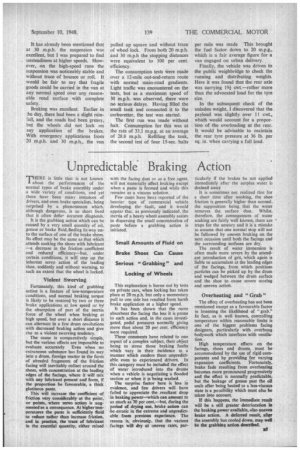Unpredictable Braking Action -1-HERE is little that is not known L
Page 39

If you've noticed an error in this article please click here to report it so we can fix it.
about the performances of the normal types of brake assembly under a wide variety of conditions, and yet there have been many instances of drivers, and even brake specialists, being surprised by a phenomenon which, although dangerous, is so short lived that it often defier accurate diagnosis.
It is the grabbing action which can be caused by a very small quantity of oil. grease or brake fluid, finding its way onto the surface of one of the brake shoes. Its effect may be the same as that which attends soaking the shoes with lubricant —a decrease in the friction coefficient and reduced efficiency—but, under certain conditions, it will step up the inherent servo action of the leading shoe, suddenly and without warning, to such an extent that the wheel is locked.
Violent Swerving Fortunately, this kind of grabbing action is a feature of low-temperature conditions, and normal braking torque is likely to be restored by two or three brake applications at low speed or by the absorption of part of the inertia force of the wheel when braking at high speed, but over a short distance it can alternate in a few drum revolutions with decreased braking action and give rise to a violent swerving tendency.
The cause is comparatively simple, but the various effects are impossible to evaluate accurately Even when no extraneous substance has found its way into a drum, foreign matter in the form of abraded fragments of the friction facing will inevitably collect around the shoes, with concentration at the leading edges of the facings, where it will mix with any lubricant present and form, if the proportion be favourable, a thick glutinous paste.
This will increase the coefficient of friction very considerably at the point. or points, where servo action is augmented as a consequence. At higher temperatures the paste is sufficiently fluid to reduce rather than increase friction, and in practice, the trace of lubricant in the essential quantity, either mixed
with the facing dust or as a free agent, will not materially affect braking except when a paste is formed and while this remains as a viscous solution.
Few cases have beda reported of the heavier type of commercial vehicle developing the fault, and it would appear tha,. as previously indicated, the inertia of a heavy wheel assembly assists in dispersing the small concentration of paste before a grabbing action is initiated.
This explanation is borne out by tests on private cars, when locking has taken place at 20 m.p.h. but only a momentary pull to one side has resulted from harsh brake application at a higher speed.
It has been shown that the more absorbent the facing the less it is prone to such action and, in the cases investigated, pedal pressures normally giving more than about 20 per cent. efficiency were required.
These comments have related to one aspect of a complex subject, their object being to stress those braking faults which vary in their incidence in a manner which renders them unpredictable even to experienced drivers. In this category must be included the effect of water introduced into the drums when a vehicle is negotiating a flooded section or when it is being washed.
The surprise factor here is less in evidence, and few drivers will have failed to appreciate the resultant drop in braking power—which can amount to as much as 70 per cent.--but, during the period of drying out, brake action can be erratic in the extreme and unpredictable from previous experience. The reason is, obviously, that the various facings will dry at uneven rates, par ticularly if the brakes be not applied immediately after the surplus water is drained away
It is sometimes not realized that for a short time after washing, the shoe friction is generally higher than normal. the supposition being that the water removes the surface dust. Whilst, therefore, the consequences of water soaking are fairly well known, there are traps for the unwary and it is a mistake to assume that one normal stop will not be followed by uneven braking on the next occasion until both the facings and the surrounding surfaces are dry.
The result of water immersion is often made more severe by the attendant introduction of grit, which again is liable to accumulate at the leading edges of the facings, from which positions particles can be picked up by the drum and wedged between the drum surface and the shot to cause severe scoring and uneven action.
Overheating and " Grab "
The effect of overheating has not been mentioned except as a favourable factor in lessening the likelihood of "grab" in fact, as is well known, controlling temperature within reasonable limits is one of the biggest problems facing designers, particularly with overhung bodywork which interferes with ventilation.
High temperature effects on the facings, shoes and drums, must be accommodated by the use of rigid components and by providing for varying expansion coefficients. Fortunately, brake fade resulting from overheating becomes more pronounced progressively and the effect is normally predictable, but the leakage of grease past the oil seals after being heated to a less-viscous state is a paisibility which must also be taken into account, If this happens, the immediate result will be a still greater deterioration in the braking power available, also uneven brake action. A deferred result, after the assembly has cooled down, may well be the grabbing action described.




















































































